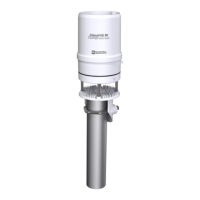diffuse day with continuous cloud cover and should be less than 6% error in total daily solar
radiation on a clear sky day.
NOTE:
Correcting for wire shadow effects is impractical because different cloud cover, time of day,
time of year, and location will cause the shadows to vary.
FIGURE 8-1 (p. 27) provides solar radiation data of ClimaVUE 50s with and without bird spike kits.
On 3/9/2019, ClimaVUE 50s with bird spike kits installed show dips in solar radiation data. The
bird spike kit did not affect the solar radiation data on completely cloudy days, when no wire
shadows are present (see 3/8/2019 in FIGURE 8-1 (p. 27)).
FIGURE 8-1. ClimaVUE 50 solar radiation data with and without bird spike kit
On a mostly clear sky day, the error caused by the bird spike kit was a decrease in total solar
radiation by 3.0% and 4.7% for two ClimaVUE 50 pyranometer sensors. On a cloudy day, the
error caused by the bird spike kit was less than 1%. On a clear sky day, the error caused by the
bird spike kit was a decrease in total solar radiation by 2.6% and 5.7%. The error was estimated by
summing the daily solar radiation of ClimaVUE 50s with bird spike kit (experimental) and without
bird spike kit (control) and calculating the percent error. Data was collected at 5 minute intervals.
Without summing daily solar radiation, the percent error when the pyranometer dips are most
drastic resulted in a decrease of 13-17% solar radiation (clear sky day). The most dramatic dips
occurred on 3/9/2019 and resulted in a decrease of 83-113 W/m
2
(FIGURE 8-2 (p. 28)).
ClimaVUE 50 Compact Digital Weather Sensor 27

